Design, Construction and Performance Monitoring of the Large-Scale Waste Rock Cover System Field Trials at the Historic Mount Morgan Mine Site in Queensland, Australia

|
Authors: O'Kane, M; Meiers, G; McCombe, C |
DOI https://doi.org/10.36487/ACG_repo/605_35
Cite As:
O'Kane, M, Meiers, G & McCombe, C 2006, 'Design, Construction and Performance Monitoring of the Large-Scale Waste Rock Cover System Field Trials at the Historic Mount Morgan Mine Site in Queensland, Australia', in AB Fourie & M Tibbett (eds), Mine Closure 2006: Proceedings of the First International Seminar on Mine Closure, Australian Centre for Geomechanics, Perth, pp. 427-440, https://doi.org/10.36487/ACG_repo/605_35
Abstract:
The Mount Morgan Mine, in central Queensland, was in operation for over a hundred years and generated 134 Mt of waste rock and tailings. The last ten years of activity at the site involved re-treatment of historic tailings. The Mount Morgan mine site is a significant source of Acid Rock Drainage (ARD) in the Dee River catchment. The State of Queensland, Department of Natural Resources and Mines (NR&M) manages the site, and in January 2000 NR&M developed the Rehabilitation Plan for the Mount Morgan mine site, Central Queensland (Unger, 2003). The objectives of the plan are to: improve water quality downstream; avoid managing ARD interception and treatment indefinitely; manage the site in accordance with its significant mining heritage; and develop and apply best-practice rehabilitation and management at this site. A seepage interception and pump-back system is currently in place, and the amount of ARD entering the groundwater system and ultimately reaching the Dee River is being quantified. A number of projects are in progress, or have been completed, towards achieving these objectives. One of these projects is the development of a cover system for waste rock material at the mine site. This project involved the construction of two large-scale cover system field trials in 2003 on acid-generating waste rock, as well as installation of field performance monitoring systems (site-specific meteorological conditions, net percolation, interflow, moisture content, matric suction, temperature, and surface runoff). In addition, a monitoring system was installed at a “natural” site in order to compare performance of an undisturbed area, in terms of storage and release of moisture, to the cover system field trials. The two cover systems are designed to limit the infiltration of meteoric water to the underlying waste rock as a means of controlling long-term acidic drainage from the waste rock dump. Test Plot 1 is referred to as a “water-shedding” cover system with a nominal 1.0 m thick layer consisting of a compacted clay layer overlain by a layer of non-compacted growth medium (weathered granodiorite), while Test Plot 2 which is referred to as a “moisture store-and-release” cover system consists of a nominal 2.0 m thick layer of growth medium. This paper will briefly describe the design and construction of the field trials, as well as the field performance monitoring system. Discussion and field performance monitoring data will be provided on the difference in performance between the two cover system field trials. Emphasis will be placed on the impact on performance of the two cover systems as a result of runoff volumes. In particular, it has been demonstrated that runoff volumes negated the intended performance of the respective water-shedding and moisture store-and-release cover design. A complete water balance for each field trial will be presented illustrating the difference in performance between the cover system field trials. Mine Closure 2006 ― Andy Fourie and Mark Tibbett (eds) © 2006 Australian Centre for Geomechanics, Perth, ISBN 0-9756756-6-4 Mine Closure 2006, Perth, Australia 427
References:
Mine Environment Neutral Drainage (MEND) (2004) Design, construction and performance monitoring of cover
systems for waste rock and tailings. Canadian Mine Environment Neutral Drainage Program, Project 2.21.4,
July.
OKC (2002) Mount Morgan Rehabilitation Project – Design of Covers over acid generating waste rock (MM401),
Stage Two Final Report, Waste Rock and Potential Cover Material Characterisation, and Cover System Design
Soil-Atmosphere Modelling. OKC Report.
Penman, H.L. (1948) Natural evapotranspiration from open water, bare soil, and grass. Proc. Roy. Soc., London, Ser.
A. No. 193, pp. 120-145.
Unger, C. and Laurencont, T. (2003) Development of a Sustainable Rehabilitation Strategy for the Management of Acid
Rock Drainage at the Historic Mount Morgan Gold & Copper Mine, Central Queensland. In Proceedings of the
Sixth International Conference on Acid Rock Drainage, Cairns, Queensland, Australia, 14-17 July, 2003, pp.
685-692.
Design, Construction and Performance Monitoring of the Large-Scale Waste Rock Cover
System Field Trials at the Historic Mount Morgan Mine Site in Queensland, Australia
M. O'Kane, et al.
440 Mine Closure 2006, Perth, Australia
© Copyright 2025, Australian Centre for Geomechanics (ACG), The University of Western Australia. All rights reserved.
View copyright/legal information
Please direct any queries or error reports to repository-acg@uwa.edu.au
View copyright/legal information
Please direct any queries or error reports to repository-acg@uwa.edu.au